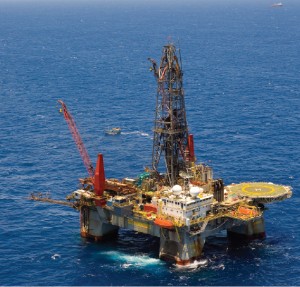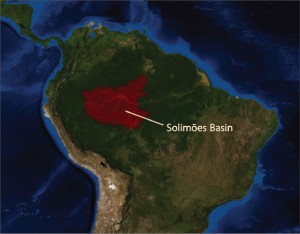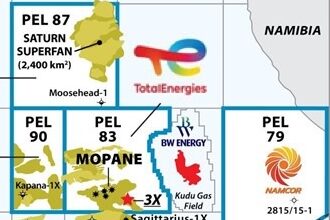Brazil: On the straightaway in an energy marathon
By Diane Langley, editorial coordinator

Any casual observer in Brazil could say that, with helicopters transporting modular rigs on land in the Amazon and the huge ultra-deepwater rigs dotting the seascape, it looks as though the country has met with an invasion of drilling rigs. The reason?
The 2016 Olympic host country is moving ahead on the straightaway in an energy marathon. And the country’s largest oil and gas company, Petrobras, is in its own sprint to become one of the world’s five largest integrated energy companies.
Poised to overtake France and Britain as the world’s fifth-largest economy, Brazil as a country is trying to figure out how to deal with the boom period in which it finds itself. As an energy player, according to the BP Statistical Review of World Energy 2010, Brazil has grown oil reserves at a fast pace – from 2.8 billion bbl in 1989 to 8.2 billion bbl in 1999 to 12.9 billion bbl in 2009.
Brazil has about 7.5 million sq km of sedimentary areas spread across 29 sedimentary basins, of which roughly 2.5 million sq km are located offshore. The country’s oil production, according to GBI Research, is expected to reach close to 5.2 million bbl/day by 2020, compared with a total of more than 2 million bbl/day in 2009. A large part of this production growth is expected to come from the subsalt basins, with the total subsalt oil production in Brazil expected to reach 1.8 million bbl/day in 2020.
Things are booming in Brazil, but one thing is missing. As Brazilian mining and oil tycoon Elke Batista said in an interview on the American television show “60 Minutes,” the country could use more skilled engineers. Representatives of various companies within the drilling industry who were interviewed for this article agree: There is a shortage of skilled petroleum personnel due to onshore and offshore demand.
International energy players
The top five companies involved in exploration activity in Brazil, according to GBI Research, are Petrobras, with 201 active assets; Petra Energia, with 52 active assets; Petrogal Brasil, with 27 active assets; OGX Petroleo e Gas Participacoes, with 22 active assets; and Vale, with 22 active assets. Other active oil companies in Brazil include Shell, Repsol Brasil, Avorada Petroleo and BP. HRT Oil & Gas is another player, which has embarked on a drilling campaign in the rainforest-covered Solimões Basin using heliportable land rigs.
Rigs operating offshore Brazil
“There are currently 136 offshore rigs operating in Brazilian waters,” said Ganesh Dabholkar, analyst for GBI Research, adding that there are 30 FPSOs and three FSOs operating offshore Brazil. The largest percentage of rig types active in the country are semisubmersibles and platform rigs, while jackups, drillships and inland barges make up the remainder.
Deep ocean activity
If one were to set sail off the coast of Rio de Janeiro and travel for about 180 miles, one would spot where many of the rigs are going – the pre-salt. A number of players have converged on this trend, and foremost in the lineup is Petrobras.
Petrobras, which had its start in 1953, had a market value in December 2010 bigger than the Industrial and Commercial Bank of China ($289.3 billion), making it the sixth-biggest company by market value in the world.
In 2004, a few exploratory wells were drilled in the Santos Basin above the salt level. It was decided that if oil were discovered with these wells, the company would drill deeper until reaching the pre-salt. In 2006, when drilling had reached a depth of 7,600 meters from the water line, a giant gas accumulation was found in the Santos Basin. The same year, another reservoir was found in the basin. Tupi, at a depth of 5,000 meters from the water line, would change Petrobras’ course for good. Seven additional wells were drilled, and oil was found in all of them. Brazil was catapulted into energy headlines around the world.

Supporting offshore exploration
Pride International, which recently entered into a definitive merger agreement with Ensco, has been in the thick of Brazilian operations for years and currently has five dynamically positioned semisubmersibles and four moored semisubmersibles operating there. Pride’s subsidiary Pride do Brasil has its primary operations base in Macae.
“What is exciting is that Brazil has a great development plan. The country has predicted to double production in four years,” said Christian Girard, Pride vice president and managing director – South America. “We believe that Brazil is a stable country with a great development plan, a well-educated population and a stable government. We are definitely pleased to be part of the effort with Petrobras and companies like OGX. We continue to see rich opportunity there.”
Pride’s commitment in Brazil had its start about 20 years ago, and the company has been active there ever since, with the Pride Portland semi flowing the first oil from a subsalt formation in Brazil from a well that had been drilled by the Pride Rio de Janeiro semi in the Jubarte Field. “Today most of our rigs are in very mature fields; one rig is drilling delineation wells in the pre-salt. But mostly it’s development drilling,” Mr Girard said. “A well is being drilled every couple of months.”
Pride is currently supporting exploration and development activity in Brazil’s offshore basins with nine semisubmersibles. The company’s “megathyst class” fifth-generation semis with rig floor automation have been purpose-built for Petrobras and are more compact and less costly to build and operate.

Four “megathyst class” rigs are under contract and are capable of working in water depths of 5,500 ft and drilling to 25,000 ft. The Pride South America, an “amethyst class” rig rated to 4,000-ft water depth and 12,000-ft drilling depth, is performing workover service in various fields in the Rio de Janeiro State. The moored units are second-generation shallow-water rigs working in mature fields. These rigs represent a good option to withstand the wind and faster currents in Brazil’s waters, according to Mr Girard, where there is more wind and current than encountered off of the coast of West Africa, for example.
Petrobras also has plans to build additional rigs in Brazil to meet the demands of its upcoming drilling programs, and seven rigs have already been signed on with local shipyards. When asked if this will affect rig utilization in the area, Mr Girard said, “With the next frontier being deepwater, we don’t believe that this will be a problem. The future oil business will need those rigs anyway. Petrobras tells us that they have 45 rigs operating with contractors and believe that they will have 90 in the next four to five years.”
“For development drilling in the pre-salt, sixth-generation drillships with 15,000-psi BOP ratings, large deck space and enhanced fluid-handling capabilities will be needed,” Mr Girard said. Such a drillship, Pride’s Deep Ocean Mendocino, is about to commence a five-year contract with Petrobras International in the Gulf of Mexico. These sixth-generation ships have two crown-mounted compensators on the derrick with active heave systems and two top drives, a 160-ton active heave-compensated subsea construction crane and eight sets of dual tensioners.
“The frontier continues to be deepwater. For the last few years, exploration success has been more than the year before. It’s only gone up,” Mr Girard said. “Petrobras has clearly been one of the leaders in this. Pride continues to look at Brazil as being a huge, very strong strategic leg in that golden triangle of deepwater drilling. Companies like Pride, who are in the deepwater and have younger, higher-spec fleets, see the opportunity long term. We continue to see a robust marketplace.”
Pride’s operations base in Brazil is set to expand with a new training center under construction in Macae. More than 70% of the company’s rig crews are Brazilian nationals, although finding qualified employees continues to be a challenge. “There’s a drag in availability of technicians everywhere in Brazil,” Mr Girard said. “There is a big demand by industry, the oil and gas business especially. The center we are building will handle both safety and technical training purposes. This is in addition to Pride’s training facilities in France and the US and training with third-party contractors.”

Technology challenge
Addressing technology challenges unique to oil and gas operations in the country, GE is an established company in Brazil, having begun operations there in 1919. GE Oil & Gas began operating in Brazil in the 1960s.
The company recently announced a order from Petrobras for $50 million in subsea equipment, bringing the total to more than 1,200 GE subsea wellhead systems installed in Brazilian waters. “Our ability to deliver reliable technology and a responsive, solutions-based approach across our localized engineering, manufacturing, sourcing and sales team were critical factors in securing these important orders,” Sam Aquillano, chief operating officer of drilling & production for GE Oil & Gas, said.
The subsea wellheads feature increased efficiency, with casing load capacity that allows operators to run longer strings, enabling larger-diameter holes. They are being manufactured in GE’s Jandira facility, where Brazilian nationals are employed.
“The country will probably double the number of rigs in a short period of time,” Mr Aquillano said. “We think the future is bright in Brazil, and we know that it requires deep domain experience. We see BOPs and drilling risers, subsea trees and platform equipment that we manufacture as a huge opportunity. Petrobras and OGX are building FPSOs, and we’re putting power and compression equipment on those FPSOs, possibly switchgear and diagnostics also.”
Among the technologies that GE has brought to Brazil are the MR-6H-SE riser system and the Quik-Log BOP that do not require as much human contact, reducing risk. The MR-6H-SE system works like an H4 connector with a cam ring that is locked down using a special spider. There are no bolts, no dogs to run in and no screws; it is a simple latch. The BOP requires less tools and allows one to actuate the BOP open, requiring less time for workers to be placed in harm’s way. The Quik-Log BOP will be installed on the Petrobras P-23 rig in Brazil and on the PetroServ Victoria rig that will also work in Brazil.
“There’s a world of opportunity for us, and we have a history of supplying leading edge technology,” Mr Aquillano said. “There are certainly technical challenges in Brazil, but the operators are leading-edge thought leaders.”
“We are growing our business and presence in Brazil by investing in technology, renewing facilities and making acquisitions,” he continued. His organization has a factory in Jandira on the outskirts of Sao Paulo and a repair facility in Macae. Both are undergoing significant investment, with new machines being installed in Jandira last year and Macae being refurbished. The Macae facility is capable of renewing state-of-the-art controls and repairing BOPs. Also, GE acquired Wellstream in early 2011 and now has a major plant in Niteroi.
A global research center located in Brazil is also on the horizon, and a significant portion of the $100-million facility will be dedicated to GE Oil & Gas research and development activity. “Our global research centers are epicenters of not only development of new technology but also deployment of existing GE technology in other fields,” Mr Aquillano said.

A sea of green
While the world’s focus on Brazil has been on the offshore pre-salt plays, much activity is also taking place in the sea of green in the Amazon rainforest. Heliportable drilling rigs are making their way to the Solimões Basin.
Tuscany International Drilling of Calgary has contracted two patented self-erecting drilling system (SEDS) rigs, 115 and 116, built by Integrated Drilling Equipment (IDE) to HRT Oil & Gas. HRT has also contracted two other heliportable rigs into the same region, and Petrobras is putting two such rigs to work in the region through Calmena Energy Services and Queiroz Galvão.
“One might ask why would you ever want to move a drilling rig by helicopter and more so why would you use a helicopter that can only lift 3,000 kilograms,” said Patrick Williams, executive vice president sales and marketing for IDE. The answer, he said, is that within the last two years the price of oil has reached all-time highs and there is a need to explore where conventional forms of transportation cannot reach.
Historically, it’s been decades since heliportable rigs were favored by the industry, according to Mr Williams. Oil prices needed to reach $80/bbl to $100/bbl to make these rigs a viable alternative.

IDE has addressed the logistical challenge by building the SEDS that is easily transportable by helicopter and requires only small lift equipment to transport the rig pieces from the helipad to the rig site.
“Not only is Brazil the oil industry’s new frontier, but the Amazon is the new offshore,” Mr Williams said. Making a comparison between Brazil’s offshore and onshore exploration, he believes they are equal in terms of remoteness, having to stretch technology and needing to meet zero-discharge regulations.
According to Mr Williams, Brazil has stepped up its natural gas production because import quotas for Bolivian gas are not being met and much of the product from Brazil’s offshore will be exported. Inland gas exploration is expected to continue at a high level for at least the next eight to 10 years. Seismic studies are also under way to explore the potential of shale gas in the central part of Brazil.
Another driver for gas exploration is socio-economic pressure from the Brazilian government to return inhabitants living in overcrowded cities to the regions from which they came, Mr Williams said. Energy infrastructure is essential to this endeavor.
“We’ve invested months of engineering to make these true helirigs, not just old iron that has been updated,” Mr Williams said. “These rigs are designed to be transported in less than 250 lifts for the main rig.” That’s more than 100 loads fewer than current rigs in the market, he said, which amounts to considerable cost savings.
The IDE design and engineering team has taken established offshore modular design concepts and added state-of-the-art electronics, automation and a proprietary hydraulics package to build these rigs. The company is supplying 800-hp, lightweight mud pumps that do not need to be broken down to the bare case. Built without gears, the pumps are also designed to be broken down into fly bricks and can be assembled or disassembled in less than one hour. In compliance with a requirement for local content, motors and generators manufactured in Brazil are being used on these rigs.
“The versatile design can include skidding capabilities, adjustable floor heights and can accommodate a number of wells and stack heights,” Mr Williams said.

Because all equipment must be brought in from the sea coast by barge using rivers and tributaries, the drill sites are accessible only during the rainy season when the rivers are high. “Logistics have been a nightmare because it takes about a month to get the rigs and associated equipment to the river base site and another month to get everything flown in, reassembled and set up,” Mr Williams said. “It takes only about one month to drill the 3,000- to 5,000-meter wells.”
A 400-man clearing crew has to be dropped into a point about 30 km to 50 km from the base site. A small staging area is cleared by hand using machetes. A camp is assembled, and helicopter-transportable equipment such as small bulldozers are flown in and assembled on the site. Then the rig is flown in and assembled. “A stain is not being left on the environment,” Mr Williams said. “All that will be left is a wellhead.” Reforestation activities will take place after drilling is completed.
HRT will start producing from its wells as early as June this year. “The oil at Solimões is the best in the whole of South America,” said Marcio Mello, CEO of HRT. Oil and natural gas production from this basin was at 102,000 bbl/day in November 2010, making it Brazil’s third-largest behind the Campos and Espirito Santo basins.





Dear Sir: it´s a good notice for Brazilian people!…..Wilson
Hi, I am looking for two 350 drilling rig (Heli portable rigs)to drill some well in areas where there is not road to get the location everything is moving by helicopter, please if you have or know some company that have these equipmente available let me know.